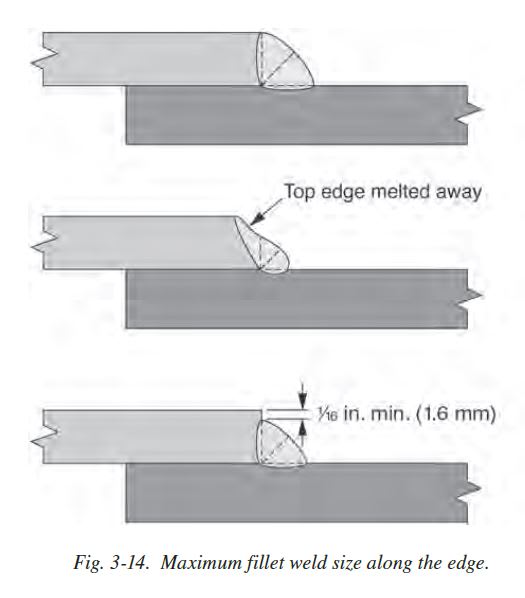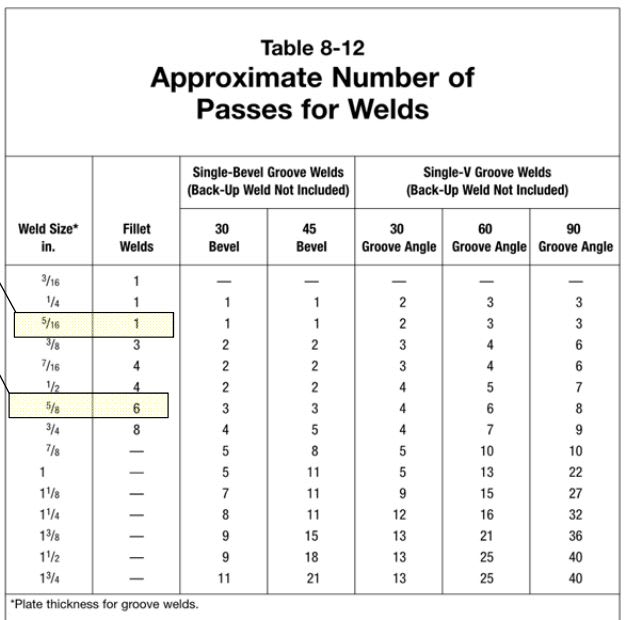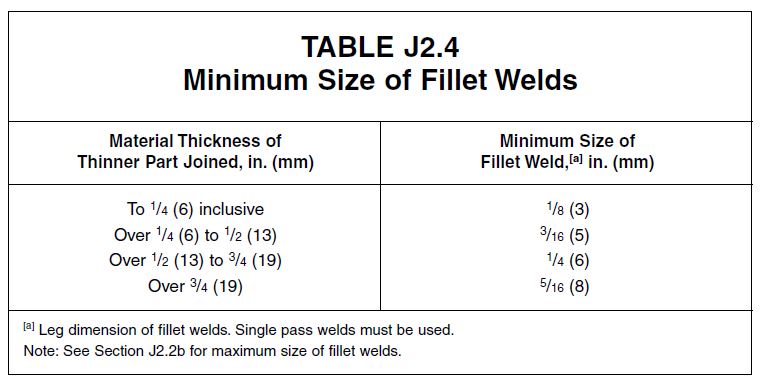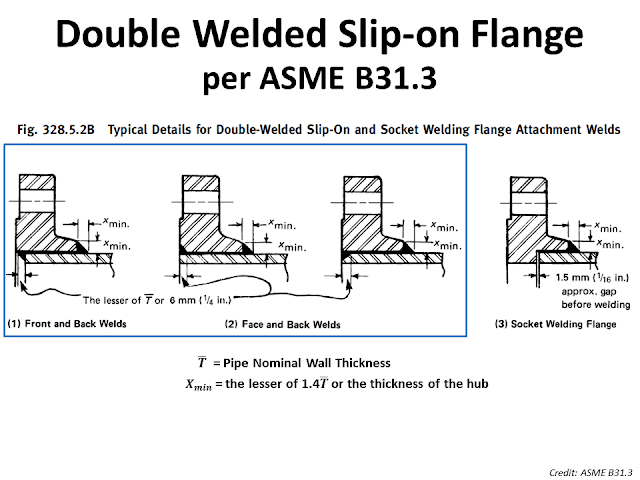Navigation
Install the app
How to install the app on iOS
Follow along with the video below to see how to install our site as a web app on your home screen.
Note: This feature may not be available in some browsers.
More options
Style variation
-
Congratulations cowski on being selected by the Eng-Tips community for having the most helpful posts in the forums last week. Way to Go!
You are using an out of date browser. It may not display this or other websites correctly.
You should upgrade or use an alternative browser.
You should upgrade or use an alternative browser.
Fillet Weld Size Based On Plate Thick 4
- Thread starter Veer007
- Start date
- Status
- Not open for further replies.
This table has nothing to do with direct calculation of strength. It's about achieving sufficient heating and penetration of the weld. If you try to do an 3/16" weld on a 1" plate, you won't get the strength you think you're getting as the weld metal and the base metal won't fuse properly.
The practical limit for this table is up to about 1.5-2". AWS and AISC have some white papers and articles addressing successful welding detailing and techniques for extremely heavy plates. I know I have a hard copy of one of them somewhere. If I find it I'll post it.
The practical limit for this table is up to about 1.5-2". AWS and AISC have some white papers and articles addressing successful welding detailing and techniques for extremely heavy plates. I know I have a hard copy of one of them somewhere. If I find it I'll post it.
-
1
- #3
phamENG's post is spot on. To expand upon what he said - it is all about the heat input of the weld. As you can see in the footnote, that is the minimum weld size and it must be done in a single pass. Along the same lines, for most weld process, 5/16" is the maximum size allowed for a single pass. So, even while dealing with thicker plates which most likely require a larger weld than 5/16" (for strength reasons), you still won't get any more heat input as the larger weld will be done in multiple passes.
The reason for the need of more heat input is multifaceted, but the main reason is to reduce the cooling rate after the weld is complete. Thick plate acts as a giant heat sink that sucks the heat right out of the weld resulting in quick cooling and brittle welds (similar to quenching a knife). This is why AWS D1.1 requires that thick plates be preheated before welding - heating the entire plate up to a certain temperature drastically reduces the cooling rate of the weld.
AISC's Design Guide 21, "Welded Connections - A Primer for Engineers" is a fantastic resource for learning more about welds.
The reason for the need of more heat input is multifaceted, but the main reason is to reduce the cooling rate after the weld is complete. Thick plate acts as a giant heat sink that sucks the heat right out of the weld resulting in quick cooling and brittle welds (similar to quenching a knife). This is why AWS D1.1 requires that thick plates be preheated before welding - heating the entire plate up to a certain temperature drastically reduces the cooling rate of the weld.
AISC's Design Guide 21, "Welded Connections - A Primer for Engineers" is a fantastic resource for learning more about welds.
- Thread starter
- #4
For example, if I have 1 1/4" thick plate and 1/4" size weld is acceptable due to force applied, I shouldn't do? right
So can I use the factor plate thick/3 to find min weld size? to make a correct fusion between thinner and thick part?
Thanks in advance!!
So can I use the factor plate thick/3 to find min weld size? to make a correct fusion between thinner and thick part?
Thanks in advance!!
Keep in mind, that table is referencing the thickness of the thinner part joined. So, if you are welding an 1-1/4" thick plate to another 1-1/4" thick plate(or thicker) then you need to use a minimum fillet weld size of 5/16" per the table. However, if you are welding a 3/8" thick plate to a 1-1/4" thick plate, this 5/16" minimum does not apply (It would be a 3/16" minimum per the table).
Once you are above the 3/4" plate thickness, the minimum weld size is never going to be larger than 5/16" as this is the maximum single pass size allowed for many common welding processes.
Once you are above the 3/4" plate thickness, the minimum weld size is never going to be larger than 5/16" as this is the maximum single pass size allowed for many common welding processes.
- Thread starter
- #6
Veer007, a 23mm fillet weld would be more in the range of 15+ passes. Some sort of groove weld would likely be more economical.
I'm not familiar with AISC, but per CSA W59 the minimum fillet weld size is based on the thickness of the thicker material, unless you're using a low-hydrogen electrode in which case you can base the min fillet weld size on the thickness of the thinner material.
I'm not familiar with AISC, but per CSA W59 the minimum fillet weld size is based on the thickness of the thicker material, unless you're using a low-hydrogen electrode in which case you can base the min fillet weld size on the thickness of the thinner material.
-
1
- #8
Veer007 said:if two 25mm plates need to be welded together, the overall weld size max can be 23mm, using more than single pass right?
Yes, that is correct.
The only time a fillet weld is limited to a maximum size is when it is made on the edge of a plate - See image below, the weld circled in red is limited per AISC J2.2b(b) while the weld circled in blue does not have a maximum size. However, as CANPRO stated, when you start getting to welds of that size, it is typically much more economical to use partial penetration groove welds rather than fillet welds.

There are a few differences between the AISC and AWS.
If one is designing and fabricating structural steel framing in accordance with AISC, go with their requirements. If AISC doesn't govern the design and fabrication of structural components, i.e., machinery, one can go with one of several AWS welding standards. AWS D1.1 is widely recognized, but there are AWS welding standards for machinery that are the D14.X documents. There are AWS standards for earth moving equipment, material handling, rotating components, etc. that may be more appropriate than D1.1.
Best regards - Al
If one is designing and fabricating structural steel framing in accordance with AISC, go with their requirements. If AISC doesn't govern the design and fabrication of structural components, i.e., machinery, one can go with one of several AWS welding standards. AWS D1.1 is widely recognized, but there are AWS welding standards for machinery that are the D14.X documents. There are AWS standards for earth moving equipment, material handling, rotating components, etc. that may be more appropriate than D1.1.
Best regards - Al
- Thread starter
- #10
Do we need 15+ passes to achieve the 23mm size of weld? and also wonder how can we decide max weld size using thick part? as far as I know if its T-Joint, the weld size must be =t-1/16", where t is the thickness, Am I wrong?
Thanks in advance!!
Thanks in advance!!
- Thread starter
- #11
- Thread starter
- #12
- Thread starter
- #13
According to my AISC manual, 3/4" is the largest "practical" fillet weld - at least that's how I interpret Table 8-12. A 3/4" weld (about 19mm) would be an 8 pass weld. They don't list passes for anything larger, which leads me to believe that they don't think anyone in their right mind would spec a larger fillet weld. I could be mistaken. A 45 degree bevel groove weld on a 1-3/8" plate (just shy of 35mm) would be a 15 pass weld.
The t-1/6" max is for lap joints. It has to do with the ability to measure and inspect the weld. If you run it all the way up to edge, then the welder will melt that top edge of the base metal and it'll be impossible to accurately gauge the size of the weld. There are probably integrity issues, too, but I was taught that the inability to inspect it was the biggest concern. J2.2b alludes to this, and I believe the commentary discusses it in more detail.
I don't have experience with field welding of oversized material, so I'm afraid I can't help with the preheat question.
No - that's a specialty situation. Those socket flanges are manufactured to certain specs and are proportioned accordingly. There is no analogous situation in a structure (unless you're using a socket flange as a base plate? Not sure I'd do that.)
The t-1/6" max is for lap joints. It has to do with the ability to measure and inspect the weld. If you run it all the way up to edge, then the welder will melt that top edge of the base metal and it'll be impossible to accurately gauge the size of the weld. There are probably integrity issues, too, but I was taught that the inability to inspect it was the biggest concern. J2.2b alludes to this, and I believe the commentary discusses it in more detail.
I don't have experience with field welding of oversized material, so I'm afraid I can't help with the preheat question.
No - that's a specialty situation. Those socket flanges are manufactured to certain specs and are proportioned accordingly. There is no analogous situation in a structure (unless you're using a socket flange as a base plate? Not sure I'd do that.)
- Thread starter
- #15
If 3/4" largest size of a fillet weld, I could use 8+8+3mm=19mm, right? have to weld 3 times in the same direction, right?
so if it is groove weld, we can active 15mm weld in a single pass, so 15+15+5mm=35mm weld, have to weld 3 times in the same direction, right?
Apologies if I'm wrong...
Thanks in advance!!
so if it is groove weld, we can active 15mm weld in a single pass, so 15+15+5mm=35mm weld, have to weld 3 times in the same direction, right?
Apologies if I'm wrong...
Thanks in advance!!
Veer007, for pre-heating the plates there should be some guidance in your welding code for certain thicknesses and grades. I could point you in the right direction in the Canadian standard, but it appears you're working with AISC/AWS. I suspect there would be similar information in those codes.
I'm not understanding your last post. I think what you're saying is a 3/4" weld is the equivalent of 2 x 3/8", which is incorrect. Your weld volume (and # of passes) is proportional to the square of the fillet weld leg - a 3/4" fillet has 4x the weld volume as a 3/8" fillet.
I'm not understanding your last post. I think what you're saying is a 3/4" weld is the equivalent of 2 x 3/8", which is incorrect. Your weld volume (and # of passes) is proportional to the square of the fillet weld leg - a 3/4" fillet has 4x the weld volume as a 3/8" fillet.
12345abc6ttyui67
Structural
Two 8mm FW and a 3mm FW does not equal a 19mm FW.
What matters is how much volume of weld metal can be deposited in a pass. As the leg length increases each pass (or volume of weld metal) is spread over a greater area and therefore provides less throat.
What matters is how much volume of weld metal can be deposited in a pass. As the leg length increases each pass (or volume of weld metal) is spread over a greater area and therefore provides less throat.
- Thread starter
- #18
Veer007, here is an image depicting the weld melting the edge of the steel that phamENG is talking about (It is from AISC Design Guide 21):

As you can see above, the weld with the top edge melted away results in the weld appearing to have a leg length that is equal to the steel thickness, however the effective throat of the weld is actually much smaller than it would be if the top edge hadn't melted away.
A T-joint weld needs to be sized based on the actual loads (with a minimum size as discussed at the top of this post). Using t-1/16 as the max size will get you into trouble if you are trying to develop the full strength of the steel - take for instance an HSS Column welded to a base plate, the fillet weld can only be made on one side due to access issues. If you are trying to develop the full strength of the HSS you will have a fillet weld with a leg size larger than the thickness of the HSS wall. The only weld that can be specified to develop the full strength of the base metal without performing calculations is a full penetration groove weld.
Here is an image giving you an idea of weld passes for different size welds:

AISC provides the following table for estimating number of passes required for certain weld sizes:

I hope this information is helping clear things up, but again, I highly recommend that you get a copy of AISC's design guide 21 - it provides a bunch of information on all of the things you are asking about.

As you can see above, the weld with the top edge melted away results in the weld appearing to have a leg length that is equal to the steel thickness, however the effective throat of the weld is actually much smaller than it would be if the top edge hadn't melted away.
A T-joint weld needs to be sized based on the actual loads (with a minimum size as discussed at the top of this post). Using t-1/16 as the max size will get you into trouble if you are trying to develop the full strength of the steel - take for instance an HSS Column welded to a base plate, the fillet weld can only be made on one side due to access issues. If you are trying to develop the full strength of the HSS you will have a fillet weld with a leg size larger than the thickness of the HSS wall. The only weld that can be specified to develop the full strength of the base metal without performing calculations is a full penetration groove weld.
Here is an image giving you an idea of weld passes for different size welds:

AISC provides the following table for estimating number of passes required for certain weld sizes:

I hope this information is helping clear things up, but again, I highly recommend that you get a copy of AISC's design guide 21 - it provides a bunch of information on all of the things you are asking about.
Preheating of plates can be (and often is) done with a simple propane torch or oxyfuel gas torch (there are much more sophisticated ways to due it as well).
A thermal gun is used to monitor the temperature of the steel to know when it has reached the correct preheat temperature. Preheating should also be done from the opposite side of the plate that the weld is to be made on (whenever possible), this ensures that the entire plate is heated up to the required temperature rather than just the surface where the weld is being made.
A thermal gun is used to monitor the temperature of the steel to know when it has reached the correct preheat temperature. Preheating should also be done from the opposite side of the plate that the weld is to be made on (whenever possible), this ensures that the entire plate is heated up to the required temperature rather than just the surface where the weld is being made.
- Status
- Not open for further replies.
Similar threads
- Replies
- 2
- Views
- 2K
- Locked
- Question
- Replies
- 3
- Views
- 1K
- Replies
- 6
- Views
- 1K
- Question
- Replies
- 7
- Views
- 9K
- Question
- Replies
- 11
- Views
- 4K


